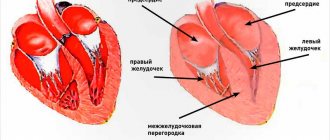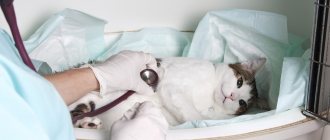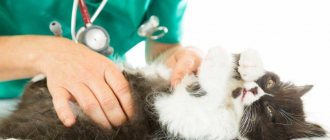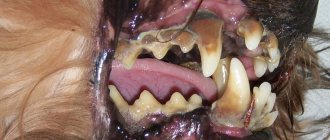Mammary gland
The mammary glands in cats are located in pairs on the stomach and chest. The work of the glands themselves begins during pregnancy, and the main function of the glands is to feed newborn kittens.
The process of milk production is regulated by hormonal processes in the body. Often these processes fail, which ultimately leads to dysfunction of the mammary gland.
Unfortunately, any cat can suffer from mammary disease, whether she has given birth or not. The three most common types of pathologies are:
- Mastitis is inflammation of the gland as a result of accumulation of milk;
- Mastopathy - swelling of the gland and discoloration of the skin around the nipples;
- Cancer is a neoplasm in the tissues of the gland.
In the early stages, it is difficult to distinguish between the symptoms of a particular disease, so if there are signs, the cat should be immediately shown to a veterinarian.
Treatment methods
Methods for treating mammary cancer in cats are radical measures. In each case, especially in the early stages, when the situation can be radically improved for the better, surgery is considered to remove the cancerous formation - the tumor.
The surgical intervention is divided into stages:
- the tumor is removed in cats, covering a large area of healthy tissue;
- nearby lymph nodes are removed to prevent further development of metastases;
- the animal is subjected to chemotherapy. This is considered the final stage of treatment, designed to eliminate the presence of a tumor process and eliminate the likelihood of a relapse.
More often, the animal is saved by surgical removal of the tumor, capturing a large area of healthy tissue and removing the lymph nodes. In some cases, the mammary gland is removed completely.
The operation is considered difficult; veterinarians do not provide guarantees for a quick and complete restoration of the pet’s healthy state. The highest rate of survival and recovery in cats after surgery occurs in the first stages of cancer. In the final stages, owners are honestly warned that the operation may not yield anything and may no longer be worth carrying out.
Depending on the type of tumor formation, the treatment method is chosen. The growth of lymph nodes suggests the beginning of treatment with surgery. The diffuse condition before surgery requires radiation therapy or chemotherapy. The goal of such treatment is to avoid early relapse.
- Radiation therapy is a local effect that significantly reduces the development of relapse during a complex of cancer treatment measures. It has become widespread in humane medicine when organ-saving operations occur;
- chemotherapy is the final stage of treatment. During this period, several strong drugs are recommended for use, for example, Doxorubicin, Cyclophosphamide. They can provide significant assistance in completely stopping the tumor process. At the same time, side effects may occur, so the animal’s condition should be monitored.
Chemotherapy is prescribed not only after surgery, but also instead of it. In the case when the doctor comes to the conclusion that due to the tumor being too small, surgical intervention can be avoided.
After surgery, chemotherapy or radiation are also used as restorative measures. At the same time, the animal is given medications. They use the traditional method, feed them with various remedies and healing decoctions. This is done after consulting a doctor.
Causes
The exact cause of cancer in cats, like in humans, has not yet been established. Experts are inclined to say that tumors in pets form as a result of living in cities with poor ecology. There is also an opinion that the animal’s body becomes a victim of cancer as a result of weakened immunity, which occurs due to poor-quality feeding and a reclusive lifestyle.
Another factor: genetics. Predisposition to tumor diseases is inherited, so it is extremely important to study the pedigree of the animal you are going to take into your home.
Types of tumors
Among all cases of tumors in cats, more than 80% are malignant. This type of disease tends to develop very quickly, spreading metastases into the animal’s body almost at lightning speed. Often, compaction occurs in several places at once. The rapid growth of the tumor causes a deterioration in the pet’s condition, which can result in death.
Benign tumors are characterized by slow growth. They are localized in a specific tissue without affecting neighboring organs. In this case, no necrotic processes are observed, which is why the type of disease is called “benign.”
The onset of the disease in both cases is characterized by the same symptoms: a small compaction appears in the cavity of the mammary gland, which does not bother the animal at the initial stage.
We'll live a little longer. (story by the owner of a 15-year-old cat with a mammary tumor) Treatment of a cat with a tumor!
(story by Natalya K., owner of a 15-year-old cat with a mammary tumor)
My cat was diagnosed with a mammary tumor. About a year ago, I felt under the skin in the lower abdomen, closer to the back right paw, a hard ball about 2 cm in size. And we are already 15 years old. But she's still such a child. Acts like a little kitten. The doctor said that as long as the tumor does not grow, there is no need to operate, and besides, due to her age, she may not be able to undergo the operation. And the operation is extensive; they said that they would remove the entire ridge. I sterilized my cat at the age of 2.5 years and was sure that this attack would pass us by. Did not work out….
The doctor advised giving the drug ASD of the second fraction for 40 days and monitoring the condition, as well as doing an ultrasound of the abdominal organs and an x-ray of the lungs to check for the presence of metastases. We did all the necessary tests and received consultations from all specialists, including a cardiologist. At that time, fortunately, no metastasis was found, but the heart, according to the cardiologist’s conclusion, may not withstand anesthesia; and age-related changes were found in the kidneys.
We decided that as long as she feels well, eats, drinks, plays, goes to the toilet without problems, and does not experience pain, we will not do anything radical.
At home, I searched numerous forums on the problem of mammary gland cancer in cats and found out that currently mammary gland cancer in cats is a pressing problem, since the incidence of this disease is high, even if the animal has been sterilized. Mammary tumors in cats account for more than 50% of all oncology, and almost all of them are malignant. And if we had survived this operation, then the risk of neoplasms appearing after some time almost in the same place and the formation of metastases in different organs is very high. And often these metastases are discovered during operations.
Life went on as usual. The cat has always been very loved, but now she is pampered more.
And two months later, my cat’s back right paw became swollen, she began to move less, lie down more, lost a little weight, but her appetite remained the same. There were no visible changes in the tumor. The doctor suggested that the swelling of the paw is associated with the progression of the disease and the accumulation of fluid occurs as a result of compression of the lymphatic vessels by the tumor, or it is metastases that disrupt the outflow of lymph in the area where the tumor is located. Since there was no talk about the operation from the very beginning, to alleviate the condition we were asked to inject baralgin, prednisolone and veroshpiron, half a tablet a day. Well, how long will we last?
After losing hope and feeling completely powerless to help a loved one, a feeling of devastation comes, and you experience tearing pain inside yourself. But almost immediately another feeling and decision came - not to give up.
I went online again and now there was only one topic: HOW to defeat cancer, even if the stage is far from the initial stage. Truly, whoever seeks will find. And I found the miracle drug GcMAF, which has been a salvation for thousands of people. Questions immediately arose: can it be used for animals, where to get it, and how long and how often it should be used. I found on the Internet that this drug is manufactured in Japan. The question of how to apply it in our case remained unanswered. Then I removed all the “veterinary” details from the search engine query and the computer told me that GcMAF in capsules can be purchased at Dr. Vedov’s clinic after consultation with a doctor . Moreover, the capsules should not be swallowed, but dissolved, pouring their contents under the tongue. How to do this in our case? I went to the clinic’s website, opening hours are from 9.00 to 21.00, phone numbers are listed. A doctor's consultation costs 3,000 rubles. For me it was a question of the life of my beloved being. I got through on the phone, explained what my case was, they immediately signed me up and I rushed across all of Moscow to the center, to the Red Gate. I don’t know WHAT the clinic staff thought about me when I rushed up to them, jumping over several steps and out of breath from running, shaking from nervous tension; but they treated me with sincere attention and sympathy. And I calmed down and began to wait for the call for a consultation. I was told that Dr. Vedov himself was waiting for me for a consultation. From this information I began to panic again, in case he laughed at my problem; for example, he will say that there are so many people who suffer, suffer from cancer, and you came to save the cat.
Doctor Vedov left the office into the corridor, smiled and said softly: “Please, come in!”
I started excitedly talking about the cat’s tumor, about its age, about the swollen paw before even reaching the office and was afraid that the Doctor would not want to listen to me with my problem or in the end would say that their clinic does not deal with animals. But the Doctor listened to me very carefully, without interrupting, and when I, having finished my confused story, asked: “Can you help?”, he answered very simply: “Yes. In Japan there are very good results in treating animals with GcMAF ." After these words, my mind calmed down, I felt that I had found support here, in the clinic, with this Doctor. And there was no longer any doubt that we would cope and cure the cat. By the way, Doctor Vedov did not charge me any money for the consultation; I only paid for the GcMAF ampoule. The doctor gave me the drug and instructions on how to inject it, and we agreed that I would regularly inform him about the progress of the treatment.
The doctor prescribed us GcMAF injections . The injections had to be given once every two days, the dosage was 0.16 ml. Injections must be made into the tumor. The number of injections is at least 10, it all depends on the body’s reaction and on each specific case. I gave the injections myself with an insulin syringe. In our case, after the third injection, I could no longer feel the tumor and the remaining injections were given subcutaneously near the place where the tumor had previously been. The swelling on the paw “went away” after 11 days. As I understand it, the amount of ml is calculated based on the weight of the animal. Just in case, I inquired about the dosage for dogs. For them, on average, the dosage is distributed as follows: 60 kg - 0.5 ml; 30 kg - 0.25 ml; 3-15kg—0.12 ml. But it must be clarified in each specific case. One ampoule of GcMAF contains 2.5 ml. The cost of such an ampoule is 30,000 rubles. And, as I understand, you can buy this drug at Dr. Vedov’s clinic.
Now my cat is running around the apartment again, jumping on the bed, on the sofa, playing with us like before. I look at her and every time I remember with a kind word Dr. Yuri Vladimirovich Vedov, who extended her life. Once again a big human and feline THANK YOU!!!
I wish you good health and further professional success! Thank you for being!
Symptoms
Since cancerous tumors develop very quickly, a timely visit to the veterinarian will allow timely treatment to begin and thereby save the animal. The following symptoms should be the reason to consult a doctor:
- Neoplasms in breast tissue. At the initial stage, the neoplasm resembles a small pea and is easily felt by palpation. It is impossible to determine the type of tumor without examination by a veterinarian. At first, the seal does not cause any discomfort to the cat.
- An increase in tumor size over a short period of time may indicate malignancy. This type of tumor can also appear in the form of a scattering of small compactions, which, as they grow, gather into small clusters.
- As the tumor grows, the cat begins to experience unpleasant sensations: the tumor puts pressure on the tissue. Often at this stage the tumor has already metastasized. It happens that the tumor bursts and opens, taking the form of a bleeding wound. In this case, you need to go to the hospital immediately.
The fate of the pet depends on the speed of the owner’s reaction, so you need to contact a veterinarian as soon as the first symptoms are detected.
Prognostic factors in cats
- Age. There is a clear correlation: the older the animal, the worse the prognosis.
- Breed: Siamese cats are predisposed to AMF. Long-haired cats have a worse prognosis than short-haired cats.
- Reproductive status: cats sterilized before 6 months of age have the lowest risk of acquiring AMD, but if formed, in most cases the tumor is extremely malignant.
- Localization: 3,4-x milk bags have the best prognosis, while 1,2-x localization, often metastasize without lymph node response, at the stage of an extremely small tumor. This is most likely due to the presence of a fatty layer between the breast tissue and the abdominal muscles in 3.4 localizations, and the direct location of the mammary gland on the external pectoral muscle in 1.2 localizations, which facilitates germination into the muscles and hematogenous metastasis.
- Tumor size. The larger the size, the shorter the life expectancy: 2 cm up to 54 months, 2-3 cm - 9 months, more than 3 cm - 5 months.
- Lymphatic metastasis: Tumor invasion into lymphatic vessels and lymphatic metastasis are poor prognostic factors.
- Type of surgery: the more radically the body is removed, the better the prognosis, even in the case of a single small, non-metastatic tumor.
- Histology: tumors invading the lymphatic vessels have a poor prognosis with MFS - 4-5 months (inflammatory carcinoma, invasive micropapillary carcinoma). Whereas ductal carcinoma – 35 months.
- Necrosis, infiltrative growth, inflammation around the tumor, ulceration, incomplete excision (tumor in the edge of the specimen.)
Diagnosis: Preoperative biopsy is usually not required as most tumors are malignant. Preoperative histological examination is carried out only on suspicious lymph nodes in order to correctly stage the process. Staging is slightly different from that in dogs.
Stages of cancer in cats
Cancer develops very quickly. The problem is that in the first stages the disease does not manifest itself in any way and does not interfere with the animal’s life. There are several stages of development of a malignant tumor:
- At the first stage, the size of the seals does not exceed one centimeter in diameter. The tumor can be detected by palpation, but the cat itself is not yet bothered by its presence;
- The second stage is characterized by an increase in the tumor up to 3 centimeters. Metastases do not appear at this stage;
- The tumor reaches 5 centimeters in diameter. At this stage, the formation of metastases is possible, which most often affects the lymph nodes located next to the mammary glands;
- The tumor is constantly growing, and metastases reach the liver, lungs and other organs.
Benign lumps on cats chest
A tumor on the mammary gland in a cat can be benign, but this is very rare. If the lump is not formed due to cancer, it is characterized by the following features :
- slow growth;
- mobility;
- there is no vascular network on the cone;
- there is no metastasis.
Treatment of such breast tumors depends on many factors. The size of the tumor, the age of the cat, the general condition of its body, etc. are taken into account. Conservative therapy is most often used. Surgical treatment is indicated only in extreme cases: if the lump is very large, or there is a risk of malignant degeneration of the tumor.
Diagnostics
The only way to determine the presence of a tumor with one hundred percent accuracy is a biopsy. The procedure is carried out very carefully, since tissue injuries can lead to the development of metastases. Along with the examination of the mammary glands, an examination of the lymph nodes is carried out.
Other diagnostic methods are also used for examination: CT, MRI, ultrasound. A blood test is performed to determine the stage of cancer.
Once the diagnosis is confirmed, the animal is prescribed chemotherapy. Biochemistry testing allows you to determine the type of treatment that is appropriate for a particular animal.
Diagnosis of a mammary tumor in a cat
If you notice any changes in the mammary gland area, you should first bring your pet to an appointment with a veterinarian. Only a specialist can make an accurate diagnosis of an animal.
It all starts with a close examination of the animal, from the tip of the nose to the tip of the tail. They examine changes in the area of the mammary gland, palpate this lesion and each gland so as not to miss changes in other areas. To know exactly which cells are in a given pathological focus, a biopsy is performed, that is, samples of cells are taken from the location of the suspicious change and subjected to careful examination. Blood samples are taken (biochemical and clinical tests) in order to know how the internal organs work, whether there are any concomitant diseases, and to eliminate risks in which surgical intervention may not be possible. All body systems are examined.
In the case of cancerous tumors, an X-ray examination of the lungs is mandatory, which excludes or, conversely, confirms the presence of metastases.
An ultrasound examination is performed only if there is a suspicion of metastases in the abdominal organs.
Any study is strictly individual for each animal. Each cat receives an individual approach. Treatment is specific depending on the development of the cancer, breed characteristics and many other factors.
Treatment
Treatment of tumor disease in cats is carried out using surgery. A similar procedure is indicated for animals with strong immunity. Weakened and elderly cats may not survive surgery, so therapy for them is limited to medication.
Do not despair if surgery is not indicated for your pet, because modern medicine offers the most powerful drugs to maintain animal health. Conservative treatment has saved many pets around the world.
In the case of a malignant tumor, surgery is the most effective method of combating the disease. The operation removes the affected tissue, which prevents cancer cells from spreading throughout the body. With luck, the surgeon can also eliminate metastases in the lymph nodes, which doubles the chances of recovery.
If the affected areas cannot be removed, the veterinarian decides to remove the mammary glands completely. It is important to understand that such an operation deals a huge blow to the cat’s body. Surgery is often prescribed in combination with chemotherapy.
The operation should only be performed by a qualified specialist. You should only trust the life of an animal to a trusted clinic.
Some owners try to help the cat on their own, which is absolutely not allowed. By self-medicating, you are putting your pet's life in danger!
If the therapy involves taking medications and chemotherapy, it is advised to leave the cat in the clinic. The reason for this: the use of highly toxic drugs that undermine the animal’s immunity. A hospitalized cat's blood is taken daily and its condition is monitored.
Stages of the disease
In cats, there are 4 stages of development of the malignant process (zero is distinguished separately):
- Stage zero - tumor less than 5 mm in size;
- The first stage is a tumor up to 2 cm in diameter without metastasis;
- The second stage is a tumor with a diameter of less than 3 cm, no metastases;
- The third stage is a tumor larger than 3 cm without metastases or less than 3 cm with metastases in regional lymph nodes;
- Stage four - a tumor with a diameter of more than 3 cm with damage to regional lymph nodes; tumor of any size with distant metastases; inflammatory carcinoma.
Prognosis and probable outcomes of the disease depend on its stage: cancer at the zero and first stages is curable in the vast majority of cases, at the second stage the prognosis is often favorable, in other cases it is rarely possible to completely cure a cat, but treatment is carried out in any case in order to prolong life animal.
However, in some cases at the fourth stage, the advisability of surgery and chemotherapy may be questionable; in such cases, maintenance therapy is carried out.
After operation
An animal that has undergone surgery needs special conditions and careful care. It is important to be able to constantly monitor the pet’s condition, so the owner is advised to stay at home during this period.
Cat after surgery
Before sending home, you need to find out from the veterinarian:
- What food should the animal be fed, as well as the amount of food indicated after surgery;
- How to treat a post-operative scar;
- The schedule for taking medications prescribed by the doctor.
After the operation, the cat is put on a special blanket, which prevents the suture from breaking and protects the wound from contamination.
To treat the sutures, the blanket is removed and returned after the procedure. All this must be done carefully. And if the integrity of the seam is damaged, call a doctor, regardless of the time of day.
Prevention of mammary tumors in cats
Firstly, if no offspring are planned from a cat, then it is advisable for her to undergo surgery, such as oophorectomy - removal of the ovaries, or ovariohysterectomy - removal of the ovaries and uterus. Such operations are recommended to be done before the first heat, at the age of six months, the risk of tumors is reduced to 90%, after the first heat - 80-85%, castration at a later age - the risk is not completely excluded.
However, if a cat regularly produces offspring, then the owners of such an animal should be as careful as possible regarding the health of their pet.
Secondly, do not use hormonal drugs that suppress sexual desire during estrus, since in addition to neoplasms, they can cause a number of other problems.
Thirdly, proper feeding and maintenance of the animal is the key to long and good health. Regular examination of the cat by a veterinarian. And, of course, the owner himself must monitor the health of his pet and devote enough time to this so as not to miss a serious illness. After all, it has always been the case that it is easier to prevent than to treat.
Prevention
There is no exact cause of mammary tumors in cats. However, it is reliably known what preventative measures pets need:
- Proper nutrition . You need to feed your cat high-quality food or natural products. You should avoid cheap food, as well as table food. Murks rarely refuse “harmful” treats, but the owner must understand that the responsibility for the pet’s health lies with him.
- Quality care . Keeping an animal includes not only feeding, but also regular visits to the veterinarian, even if the pet is apparently healthy. It would also be a good idea to examine the animal at home. If you feel unwell, you should consult a doctor and not self-medicate.
- Sterilization , if the animal does not participate in procreation. This procedure significantly reduces the risk of tumors and completely eliminates the possibility of developing malignant tumors. In the absence of sexual activity for a long time, unsterilized animals are at risk.
- Abstinence from treatment with hormonal drugs. Such drugs cause enormous harm to the body, often leading to disastrous consequences.
- Timely medical assistance for any kind of ailment. This is especially true for diseases of the genitourinary system, as well as mastitis.
Quality care is the best prevention
A mammary tumor in a cat is a serious disease that requires immediate medical intervention. Timely diagnosis and assistance will help save your pet's life.
If you have any questions, you can ask us in the comments section.
Types of malignant tumors
Abscess in a cat: paraanal gland, on the paw, treatment
There are 4 types of mammary tumors that can occur in a cat. Most of them begin their development from the glandular epithelium. In turn, they are divided into groups:
- adenoma and fibroadenoma. These two types form a group where cancer is associated with a benign course. This phenomenon is rare in animals;
- carcinoma or adenocarcinoma. The group that corresponds to the malignant course of the oncological disease process that affects the mammary gland in a cat. These varieties occur more frequently. They originate in the epithelium of the ducts and alveoli located in the mammary glands.
Of the two components of the group, inflammatory carcinoma of the mammary glands is considered particularly dangerous. If a cat has a swollen mammary gland, then in the presence of carcinoma an inflammatory process occurs. This is where the likelihood of an unfavorable prognosis comes from. The occurrence of mixed tumors threatens the ductal and epithelial tissues in the mammary glands, but here there is hope for a more favorable outcome of the disease.
Types of mammary tumors in cats
Breast carcinoma is identified by a mobile nodular formation. In stages 3 and 4 of cancer, these formations may open or cause constant bleeding. Damage to the mammary gland most often occurs on one side. It is much less common for both parties to suffer. The disease is characterized by enlarged lymph nodes, felt largely in the groin and axillary area. The bloody area on the animal’s body becomes clearly visible. It begins to smell peculiar.










